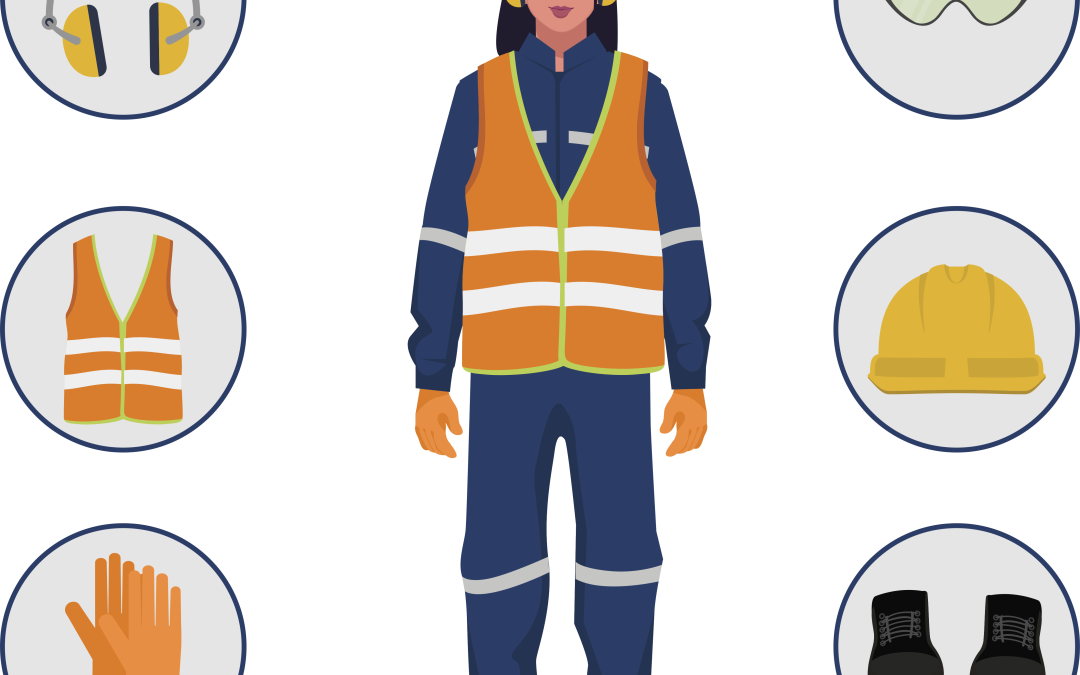Personal Protective Equipment (PPE) is specialized clothing or equipment worn by an employee to provide protection against a hazard (e.g., infectious agents and toxins). General work clothes (e.g., uniform, pants, shirts, blouses) are not intended to function as protection against a hazard and are not considered to be PPE.
PPE can be as basic as eye protection (safety glasses or goggles), gloves, and a lab coat or as complex as a Biosafety Level 4 “positive pressure suit” that completely isolates the employee from the laboratory environment. The use of specific PPE required is determined through a risk assessment.
The characteristics of the infectious agent or toxin being manipulated and the type of laboratory procedures performed will determine the type of PPE required. If there is a risk of creating an infectious biological aerosol (suspension of very fine particles or droplets in the air), use of the proper respirator will prevent the worker from inhaling the infectious aerosol. This work can also be conducted in a biosafety cabinet to contain any aerosols created.
Personal Protective Equipment Terms
| Term | Definition |
| Aerosol | Describes microscopic droplets that may contain infectious agents or toxins, similar to the droplets produced by a sneeze or a cough. Some laboratory procedures including sonication, centrifugation, vortexing, flow cytometry, fluorescence-activated cell sorting (FACS) and homogenization can produce aerosols. These procedures should only be performed within a primary containment device. More information on aerosols is available from CDC. |
| Mucous Membrane and Respiratory Protection | Protective devices that are worn by the user to reduce or eliminate exposure to infectious materials (e.g., inhaling particles or liquid sprays). Such devices include surgical masks and face shields that protect mucous membranes against exposures from liquid droplets, dual and single cartridge half-mask and full-face respirators, gas masks, powered air-purifying respirators, supplied-air respirators, and self-contained breathing apparatuses (SCBA). Biosafety in Microbiological and Biomedical Laboratories includes guidance on the type of mucous membrane and respiratory protection that may be required for work conducted with infectious agents or toxins. CDC issues guidance for work with new or emerging agents or toxins, which frequently includes information about respiratory protections. |
| Sharps | Needles or other sharp instruments capable of breaking the skin. |
| Gloves | Designed to protect hands from contact with potentially hazardous materials (e.g., infectious agents and toxins or corrosive chemicals). Procedures for removing gloves to minimize contamination are taught in laboratories and some videos are available online. Gloves are made of different materials such as latex and nitrile. Nitrile gloves can be used by people who are allergic to latex. |
| Goggles and Safety glasses | Provide eye protection from splashes of chemicals or liquids containing infectious agents or toxins. Laboratory goggles and safety glasses should include shields on sides to prevent splashes at an angle from reaching the eye. For people who wear glasses, prescription goggles are available. |
| Lab Coats and Gowns | Protect skin and street clothing from potential hazards such as materials containing infectious agents or toxins and dangerous chemicals when working in a laboratory environment. Most lab coats can be washed and decontaminated. Gowns, on the other hand, are usually disposed of with other contaminated waste. PPE for work in a BSL-4 suit laboratory includes the use of a positive pressure suit connected to a HEPA filtered airline. The positive pressure suit completely isolates the laboratory worker from the laboratory environment, ensuring there is no contact with potentially hazardous material (e.g., infectious agents and toxins). Laboratory personnel who work in positive pressure suits require significant training. |
Spencer-SHE has been providing Safety, Health, and Environmental Compliance Guidance since 1980. Through risk assessments, our team can formulate the selection of appropriate practices, safety equipment and facility safeguards. Risk assessment is a common first step in an overall risk-management process.
Contact us here to help you to develop and maintain a safe and healthy workforce.
Sources:
Photo: Shutterstock
https://aspr.hhs.gov/S3/Pages/Personal-Protective-Equipment.aspx

